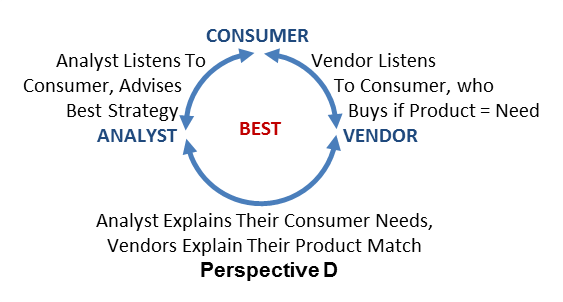In any given industry, there exists a symbiotic relationship between vendors, analysts and customers. Each one is vying for their piece of nirvana: the best value for their dollar spent. In an industry, such as the IT industry, where analysts play a significant role, it is assumed that they are the “influencers” in the market, but in reality, it doesn’t always, and shouldn’t, work that way.
Earlier this year, Steve Loudermilk (@loudyoutloud) and I started the #ARchat group on Twitter to discuss issues involving the Analyst/Influencer Relations industry: essentially an open forum to discuss how vendor-based Analyst Relations (AR) professionals and Industry Analysts interact (I use the term “industry” here to differentiate from financial or other types of analysts). Through the course of the year, we’ve covered many topics that have yielded some very interesting discussions.
Throughout all of these discussions, however, I’ve been noticing a common thread involving “influence” and the fact that not everybody views the influencer:influencee relationship in the same manner. The most common mis-perspective is the traditional viewpoint that the Analyst is the market’s influencer (since their role is to be a trusted advisor to their client – the Vendor’s consumer – by providing advice regarding technologies, trends, implementation strategies, etc. that “influence” their clients actions). However, that is an incomplete view, that leaves out the more complicated relationships with Vendors and Clients/Consumers.
In this view (Perspective A), the Analyst sits atop the influence model as the sole provider of guidance to both Consumers and Vendors. Sorry, but this just isn’t how it works. Perspective B provides a bit more clarity, demonstrating that a good Vendor “educates” an Analyst about their product capabilities, and the Analyst then provides the the appropriate advice/guidance to their Client (the Vendor’s Customer) who can then make their own choice, based on what is right for their needs (features, budget, availability, scalability, etc.). But even this viewpoint, while better, is still incomplete.

Hopefully, as shown in Perspective B, the Vendors and Analysts learn to share information in a two-way manner. But more importantly, there are, in fact, three distinct influencers in any given market, the Vendor, the Analyst AND the Client/Consumer. Perspective C shows a more complete “sphere of influence”,  and how symbiotic each of the three different groups are (note here that there is a tangential sphere of influence that exists solely within the Consumer community, a great example being Trade Associations, who tend to have their own collaborative exchange and discussions about best practices when it comes to Vendor products & implementation strategies).
and how symbiotic each of the three different groups are (note here that there is a tangential sphere of influence that exists solely within the Consumer community, a great example being Trade Associations, who tend to have their own collaborative exchange and discussions about best practices when it comes to Vendor products & implementation strategies).
But the most complete picture of how a market sphere of influence works is when you take a look at Perspective D. In this influence model, you can see that the entire market is driven by a series of multi-directional channels of communication, where each of the three players (Vendors, Analysts, Consumers) have their own way of providing influence (in the form of information, requirements, capabilities, etc.) that get communicated to the other two players in the market.
 In this way, the best possible product offerings can be designed and deployed, giving each of the three participants what they need – the best value for their dollar spent. Note too that in Perspective D I have placed the Consumer at the top of the circle, since they ultimately control what is purchased, and their needs and requirements should be what ultimately influences the market.
In this way, the best possible product offerings can be designed and deployed, giving each of the three participants what they need – the best value for their dollar spent. Note too that in Perspective D I have placed the Consumer at the top of the circle, since they ultimately control what is purchased, and their needs and requirements should be what ultimately influences the market.
Unfortunately, this isn’t always how the system works. And, of course, there are a series of other methods that dictate how information and requirements (and thus influence) are distributed through the group. But in the basic world of Vendors, Analysts and Customers, this sphere of influence is definitely a 3-way street with the Customer directing traffic.
